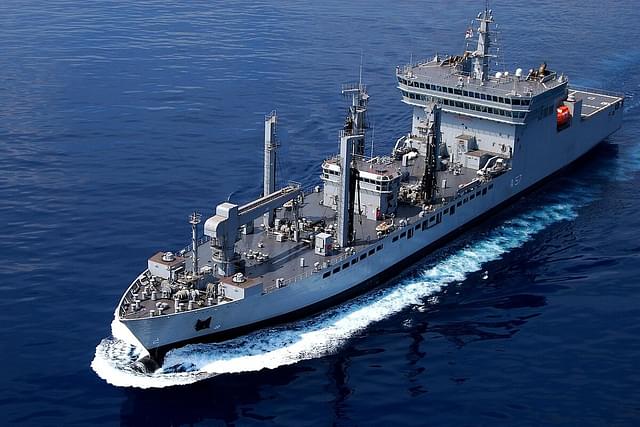Defence
Indian Navy In South China Sea - The Usual And Unusual
Venu Gopal Narayanan
May 25, 2024, 03:41 AM | Updated 07:23 PM IST
Save & read from anywhere!
Bookmark stories for easy access on any device or the Swarajya app.

Hectic campaigning was still in progress for the third phase of general elections earlier this month, when three sleek ships of the Indian Navy departed eastwards for a lengthy operational deployment in the South China Sea.
Cutting the sea swell into foam at the vanguard was the INS Delhi, a guided-missile destroyer armed to the teeth with Brahmos and Barak missiles. Following her was the anti-submarine warfare corvette, the INS Kiltan, and supplying the two was the fleet tanker INS Shakti. While the Delhi visited Singapore and Malaysia, the Kiltan would continue on to the Philippines.
The deployment didn’t raise much fuss initially, save wire reports which pointed out that two vessels of the German Navy had also been deployed to the same area in the same period. But on 20 May, a Hong Kong-based newspaper of record ran a lengthy piece on the Indian Navy’s deployment, hinting about “a danger that the ships could provoke an “aggressive response” from China”.
It was a needless observation unworthy of even a mouthpiece since, if an aggressive response was indeed a material risk, then surely the Indian Navy would have factored it into their calculations; and in any case, no one was better suited to run such risks than the Indian Navy.
Besides, most such deployments are political decisions, taken to further specific aspects of India’s foreign policy. But the fact that the newspaper saw fit to comment as it did, raises eyebrows.
What might the purpose of this voyage by the Indian Navy be?
First, is it linked to the deployment of the two German vessels? Probably not, since such a degree of coordination with the German Navy effectively means coordination with the North Atlantic Treaty Organization (NATO), and that is not Indian policy.
Also, we mustn’t read too much into the German naval deployment since the Chancellor of Germany was on a state visit to Beijing just last month. It is another matter entirely, that the German Navy poses a greater threat to itself rather than a foe (see here for a hilarious account of their recent blunderings in the Red Sea).
Second, is the Indian deployment merely routine? One might have thought so, prima facie, but the Kiltan’s deployment to the Philippines suggests different.
While it is quite common for Indian surface combatants to make routine goodwill visits at ports around the world, having the Kiltan visit the Philippines precisely when that nation is potentially on the cusp of a pivot back towards America, and embroiled in a messy maritime boundary dispute with China, is uncommon.
Further, the Kiltan was in the Philippines just as China initiated its truly alarming ‘Joint Sword 2024A’ military exercises, in which, a massive tri-service force of the Chinese Eastern Command surrounded Taiwan to simulate an invasion.
The distance between the exercise area and the Philippines is barely 300 kilometres. And what better naval platform to track movements and pick up signals, both above and below the surface, than an anti-submarine warfare corvette?
Is that why the Indian Navy dispatched an older model of this ship class – so that even if the Chinese were listening back at us, or trying to electronically jam the Kiltan, they would encounter only Indian electronics from an earlier generation?
Or, third, is the timing of this Indian deployment payback for last year, when Chinese vessels in the South China Sea abruptly changed course to threaten an interception of the May 2023 India-ASEAN naval exercises?
The INS Delhi, which was part of that exercise, actually ‘ran dark’ for many hours (meaning, it switched off its active sensors and went off the radar) until the Chinese vessels sailed through the exercise, pressing home Beijing’s point of unhappiness.
Or, fourth, is the deployment an indicator that a hot summer beckons? After all, the true reasons for Prime Minister Modi’s uncharacteristic, curious two-day visit to Bhutan in late March of this year, after general elections were announced, have not yet been made public.
Many felt, at the time, that the visit was made in anticipation of potential rumblings on the border, either during the course of the elections, or soon thereafter.
If so, it ties in with two things: one, Foreign Minister S Jaishankar’s campaigning during the general elections.
It is an aspect which, for the larger part, has gone either under-reported or unnoticed: throughout this season, every other day, in one corner of India after another, he has sought to patiently explain the incumbent government’s foreign policy, and the strategic challenges it faces, in simple, layman terms, in the vernacular.
This communication has meaning, which extends beyond mere elections.
Two, it also ties in with a report from 2022 September by Swarajya, which suggests that India has, over the past decade, devised a ‘Forward Policy’ with a difference vis-à-vis China.
By it, India shall actively strive to ensure its national aims and interests, whether such a course is to China’s liking or not, with the onus on China to change its stance towards India if it indeed seeks improved bilateral ties.
Whatever be the truth of the Indian Navy’s deployment to the South China Sea, one point is clear: this government does not do routine.
Save & read from anywhere!
Bookmark stories for easy access on any device or the Swarajya app.
Venu Gopal Narayanan is an independent upstream petroleum consultant who focuses on energy, geopolitics, current affairs and electoral arithmetic. He tweets at @ideorogue.
Support Swarajya's 50 Ground Reports Project & Sponsor A Story
Every general election Swarajya does a 50 ground reports project.
Aimed only at serious readers and those who appreciate the nuances of political undercurrents, the project provides a sense of India's electoral landscape. As you know, these reports are produced after considerable investment of travel, time and effort on the ground.
This time too we've kicked off the project in style and have covered over 30 constituencies already. If you're someone who appreciates such work and have enjoyed our coverage please consider sponsoring a ground report for just Rs 2999 to Rs 19,999 - it goes a long way in helping us produce more quality reportage.
You can also back this project by becoming a subscriber for as little as Rs 999 - so do click on this links and choose a plan that suits you and back us.
Click below to contribute.





